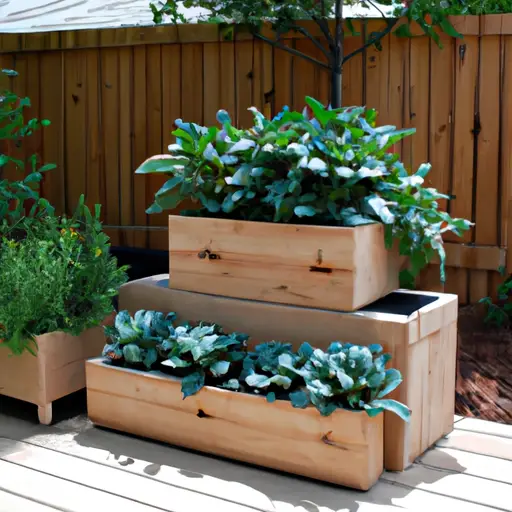Creating a Bountiful Edible Oasis with a Vegetable Container Garden
In recent years, urban farming has gained immense popularity as people become more conscious about their food choices and the environmental impact of traditional agriculture. Limited space, however, can be a major hindrance for those who dream of growing their own vegetables. Fortunately, an innovative solution lies in the form of vegetable container gardens, which enable individuals to cultivate thriving, bountiful crops even in small urban settings. In this article, we will explore the benefits of vegetable container gardens and provide you with practical tips on how to create your very own edible oasis.
1. Maximizing Space
One of the primary advantages of a vegetable container garden is its ability to maximize limited space. Whether you have a small balcony, rooftop terrace, or just a sunny windowsill, you can transform it into a productive garden. With container gardening, you are not limited by traditional garden layouts or soil conditions and can make the most of every square inch available.
2. Flexibility and Mobility
Container gardens offer tremendous flexibility and mobility compared to traditional gardens. You have complete control over sun exposure and soil quality since containers can be easily moved around to optimize growing conditions. If certain plants require more sunlight or shade at different stages of growth, simply relocate the containers accordingly.
3. Accessibility and Convenience
Another advantage of container gardening is its accessibility and convenience. Unlike conventional gardens that involve bending down or kneeling to tend to plants, containers can be placed at waist height or on raised platforms for easy access. This feature makes gardening more convenient for people with physical limitations or those who prefer not to strain their backs.
4. Health Benefits
Growing your own vegetables has several health benefits beyond providing fresh produce. Spending time outdoors in nature while tending to your garden promotes relaxation and reduces stress levels. Additionally, studies have shown that engaging in active gardening activities helps promote physical fitness by improving flexibility, strength, and coordination.
5. Choosing the Right Containers
When selecting containers for your vegetable garden, it is important to choose appropriate sizes and materials. The containers should have drainage holes to prevent waterlogging and promote healthy root growth. Plastic pots are lightweight, affordable, and easy to move around; however, they can retain heat and require additional watering in hot climates. Terracotta pots, while aesthetically pleasing, can become heavy when filled with soil and may dry out more quickly. Self-watering containers are another option to consider if you have a busy schedule or tend to forget watering your plants.
6. Soil Selection
Choosing the right soil mix is crucial for the success of a vegetable container garden. Opt for a well-draining potting mix that retains moisture while allowing excess water to escape through drainage holes. A high-quality organic potting mix enriched with compost ensures optimal nutrition for your plants. Avoid using garden soil as it may contain pests or diseases that could harm your plants.
7. Plant Selection
The choice of plants depends on your preferences, available space, and growing conditions such as sunlight exposure and temperature range. Leafy greens like lettuce, spinach, and kale are excellent options for beginners as they are relatively easy to grow in containers. Tomatoes, peppers, cucumbers, herbs, and dwarf varieties of fruit trees can thrive in containers too but require larger pots due to their extensive root systems.
8. Watering and Fertilizing
Consistent watering is crucial in container gardening since pots can dry out faster than traditional gardens due to increased exposure to air circulation. It is essential to monitor the moisture levels regularly by inserting your finger into the soil before watering again – if it feels dry up to the first knuckle, it’s time to water the plants.
To maintain robust growth and productivity, fertilize your container garden regularly with organic fertilizer or compost tea during the growing season. This will replenish nutrients that may have depleted over time.
9. Pest and Disease Management
Container gardens are generally less prone to pests and diseases compared to traditional gardens, but it’s still important to be vigilant. Regularly inspect your plants for signs of infestation or disease, such as discoloration, spots, or wilting leaves. Organic pest control methods like introducing beneficial insects, using natural predators, or employing organic insecticidal soaps can help manage infestations without the use of harmful chemicals.
10. Harvesting and Enjoyment
One of the most rewarding aspects of container gardening is harvesting your own fresh produce. Harvest leafy greens by picking individual leaves continuously throughout the growing season to encourage further growth. For fruits like tomatoes and peppers, wait until they reach their optimal size and color before gently plucking them off the plant.
In conclusion, a vegetable container garden offers numerous benefits for urban dwellers who dream of cultivating their own thriving oasis of fresh produce. With limited space and mobility concerns being addressed by container gardening, anyone can embark on this fulfilling journey towards sustainable food production. Start with a few containers today and experience the joy of growing your own bountiful edible oasis right at home!














